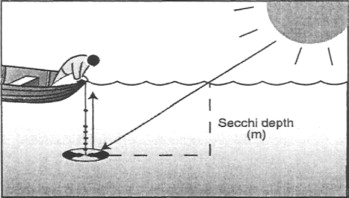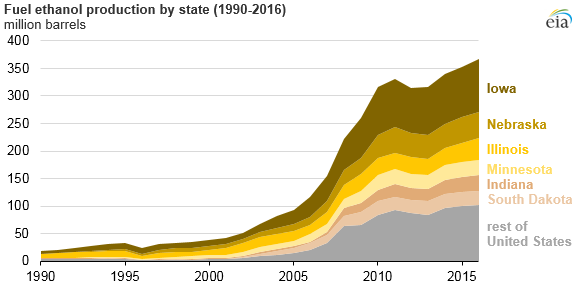Secchi depth is a water quality measurement of clarity. An 8”-diameter black and white disk is lowered into the water (flat side parallel to the water’s surface) and the first depth at which it can’t be seen is recorded. It’s one of the oldest of all quantitative water quality measurements. Catholic priest Pietro Angelo Secchi demonstrated the technique to Pope Pius IX while onboard the pope’s yacht in 1865.

We still use this simple but elegant method today and Iowa DNR’s ambient water monitoring program assesses lakes for clarity in this manner. Research shows that the public’s perception of “good” water quality corresponds to a Secchi depth of about 3 feet; in other words, a depth where you can see your toes when standing in waist deep water (1).
Iowa has a little over 100 lakes, and their degraded condition keeps DNR busy restoring them. You can easily make the case that lake restoration is the best thing Iowa DNR does. They know how to take a cloudy lake filled with sediment, phosphorus and carp and turn it into a clear one with bass and walleye in short order. The problem we have is that agriculture seems to prefer the former and so lake restoration in Iowa is more like a perpetual jobs program for earth movers to bulldoze sediment out of drained lakes on a regular and never-ending schedule. There should be a smartphone app for Iowa lake users that shows which have been recently restored and then you can plan out your weekend trips for the next 4-5 years, after which the app will tell you which lake to go to next based on the DNR restoration schedule.
There are several constructed lakes in southern Iowa where the topography is favorable for lake impoundment. Some of these serve as municipal drinking water source supply for nearby communities—Chariton, Corning, and Osceola are three, and some of these systems have struggled with atrazine impairment of the drinking water. Taylor County’s Lake of Three Fires north of Bedford is the focal point for the state park of the same name, and, according to Iowa DNR (2), “was dedicated in 1935 and is named after a group of Native Americans from the Potawatomi tribe who once inhabited the area known as the ‘Fire Nation’.” There were a number of WPA and CCC projects in Iowa and elsewhere during the 1930s that focused on drinking water supply, lake construction, and natural resource enhancement in parks.
By the early 2000s, the volume of Lake of Three Fires had shrunk 40% and the maximum depth halved because of sedimentation. Iowa DNR and Iowa Department of Agriculture and Land Stewardship (IDALS) worked with watershed landowners to reduce sediment transport to the lake. The lake was drained in 2004 and about 400,000 cubic yards of sediment were removed. The lake was refilled and stocked with bluegill, catfish, and largemouth bass. Prior to this, the Secchi depth had never been greater than 18 inches. In the few years following restoration, lake clarity sometimes reached 6 feet, nearly unheard of for any Iowa lake this side of West Okoboji, which is kept clear by its enormous depth.
Then something happened. Ethanol happened.
Congress authorized under the Energy Policy Act of 2005 and this was expanded under the Energy Independence and Security Act of 2007 (3). The act began by requiring 4 billion gallons of renewable fuel in 2006 with an expectation that the amount would increase to 36 billion by 2022. This created a guaranteed market for corn and agriculture responded. Although Iowa has always had a lot of land planted to corn, this area of southern Iowa, discussed at length in Neil Hamilton’s book, The Land Remains, has a lot of hilly ground that is considered marginal for corn production. Land value in Taylor County, where Lake of Three Fires is located, is ranked 93rd out of Iowa’s 99 counties. The average value of Taylor County farmland tripled between 2000 and 2010, an increase slightly larger than state as a whole over the same period.

The guaranteed market for corn shepherded pasture and idle land into corn production in Southern Iowa. Corn area in Taylor County increased 34% between 2003 and 2013, and this wasn’t just any ground—this was land vulnerable to erosion and other environmental degradation. The good stuff was already being farmed. This is apparent from aerial photos of Taylor County (3). The images below show a hillslope in the lake’s watershed just north of the park (the waterbody on the left is not Lake of Three Fires, but rather a pond). The 2004 image shows mostly pasture with a cropped field on the hilltop to the right. The 2010 image shows a sea of green corn planted to the entire hillslope.
The lake responded, predictably. By 2012, the lake had returned to its pre-restoration clarity, or lack of clarity, as the case may be. The graph below shows a 3-year running average of Secchi depth, depicted with the blue line and corresponding to the y-axis on the left. I used negative numbers here to illustrate how you could see further down into the lake immediately after restoration. The graph also shows Taylor County corn acres in the green line, corresponding the y-axis on the right. Although Lake of Three Fires provides the best lake example of the degradation caused by fuel ethanol, you don’t have to look far to find other examples, such as Lake Icaria in Hamilton’s Adams County. The restoration project at Lake of Three Fires required $3.8 million, of which $2.3 million was spent on the lake itself and the balance spent on other park improvements.
I’m sure you know that using Iowa’s natural environment to produce automobile fuel has wide bipartisan support, as demonstrated by the votes recorded on the recently passed E-15 law, which requires 15% ethanol blends be sold at all Iowa gas stations and provides taxpayer cost share for stations to purchase new pumps. Some quotes to that effect:
Democratic State Senator and Johnson County farmer Kevin Kinney: "32 percent or more of our budget is directly related to the ag industry" and E15 is "a step in the right direction." (5)
Senate minority (D) leader Zach Wahls, also from Johnson County: “This legislation is a win-win for the Iowa economy.” (5)
U.S. Congressperson (D) Cindy Axne: “I have been fighting tooth and nail to make sure biofuels is a part of the clean energy solution.” (5)
Governor Kim Reynolds (R), upon signing the E15 bill: “I’ve never been prouder than I am today to be the Governor of the number one ethanol and biodiesel-producing state in the country.” (6)
So what are we to make of this and other similar situations? We've recently been told by our secretary of agriculture that farmers are not likely to adopt conservation unless it pencils out for them as profitable (7). At the same time, we subsidize the activity that creates the pollution, indemnify the risk of that production, help the industry market their products, force the public to buy the products, and then, in the case of our lakes, ask our agency to travel the countryside to repair the damage that predictably results. The depravity of this is so perverse and so unexplainable and so illogical that this is what we're left with: we celebrate it.
Over the past few years, I’ve come to realize that Iowa’s water quality will not recover in my lifetime to a condition that any reasonable society would consider adequate.
I think you should know why.
- Brown, E., 2008. Nutrient Criteria for Iowa Lakes Recommended Criteria for Class “A” Recreational Uses Report of the Nutrient Science Advisors. February 14, 2008
- Lake of Three Fires State Park. Iowa Department of Natural Resources.
- The Renewable Fuel Standard (RFS): An overview. Congressional Research Service, January 31, 2022.
- Iowa Geographic Map Server, Iowa State University Geographic Information Systems Support and Research Facility. https://ortho.gis.iastate.edu/client.cgi?zoom=1&x0=358597&y0=4511058&layer=naip_2005_nc&action=layernaip_2010_nc&pwidth=800&pheight=625
- Belin, L. Iowa Democrats won't speak truth to ethanol power. Bleeding Heartland, April 28, 2022.
- Office of the Governor, May 17, 2022. Gov. Reynolds signs bipartisan Biofuels Bill into law at farm in Prairie City.
- Hoffman, D. IDALS working to better water quality in Iowa. IDALS working to better water quality in Iowa. Iowa Agribusiness Radio Network, May 25, 2022.